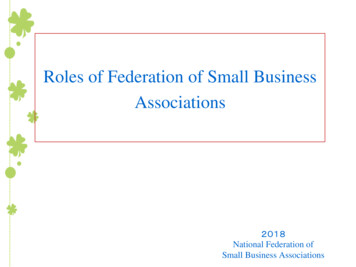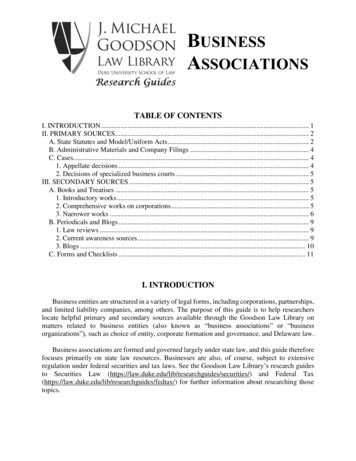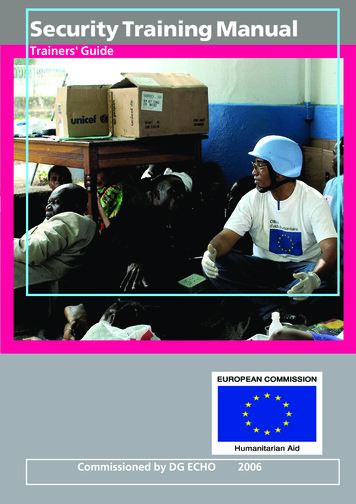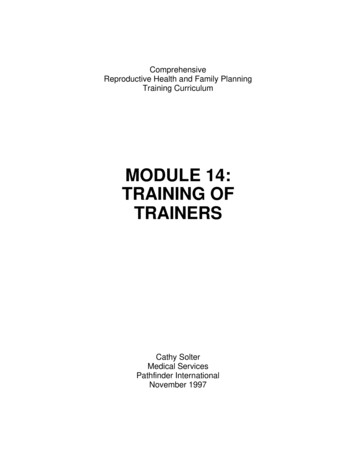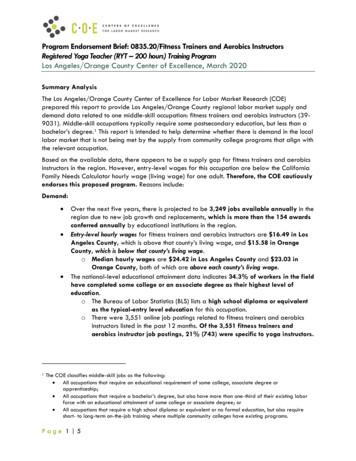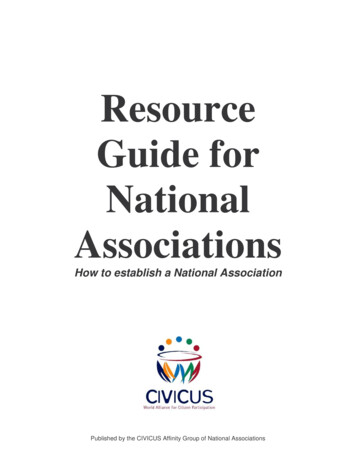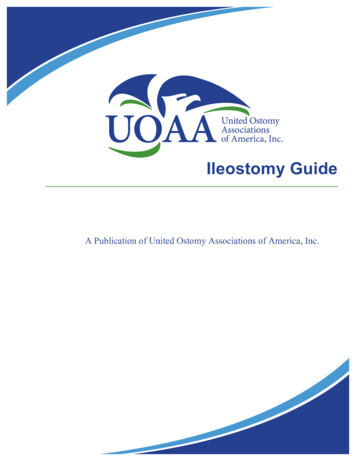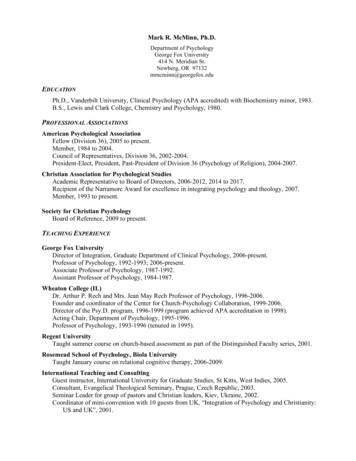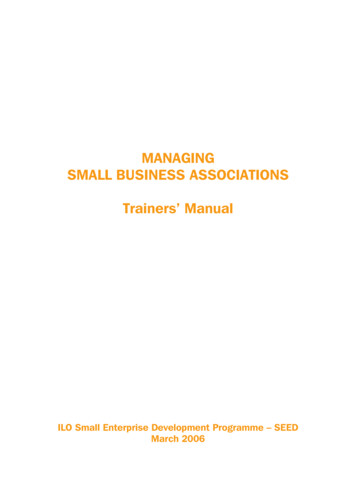
Transcription
MANAGINGSMALL BUSINESS ASSOCIATIONSTrainers’ ManualILO Small Enterprise Development Programme – SEEDMarch 2006
Copyright International Labour Organization 2006First published 2005Publications of the International Labour Office enjoy copyright under Protocol 2 of the Universal CopyrightConvention. Nevertheless, short excerpts from them may be reproduced without authorization, on condition thatthe source is indicated. For rights of reproduction or translation, application should be made to the PublicationsBureau (Rights and Permissions), International Labour Office, CH-1211 Geneva 22, Switzerland, or by email:pubdroit@ilo.org. The International Labour Office welcomes such applications.Libraries, institutions and other users registered in the United Kingdom with the Copyright Licensing Agency, 90Tottenham Court Road, London W1T 4LP [Fax: ( 44) (0)20 7631 5500; email: cla@cla.co.uk], in the United Stateswith the Copyright Clearance Center, 222 Rosewood Drive, Danvers, MA 01923 [Fax: ( 1) (978) 750 4470; email:info@copyright.com] or in other countries with associated Reproduction Rights Organizations, may makephotocopies in accordance with the licences issued to them for this purpose.ILOManaging Small Business AssociationsTrainer’s ManualGeneva, International Labour Office, 2006ISBN 92-2-XXXXXX-XILO Cataloguing in Publication DataThe designations employed in ILO publications, which are in conformity with United Nations practice, and thepresentation of material therein do not imply the expression of any opinion whatsoever on the part of theInternational Labour Office concerning the legal status of any country, area or territory or of its authorities, orconcerning the delimitation of its frontiers.The responsibility for opinions expressed in signed articles, studies and other contributions rests solely with theirauthors, and publication does not constitute an endorsement by the International Labour Office of the opinionsexpressed in them.Reference to names of firms and commercial products and processes does not imply their endorsement by theInternational Labour Office, and any failure to mention a particular firm, commercial product or process is not a signof disapproval.ILO publications can be obtained through major booksellers or ILO local offices in many countries, or direct fromILO Publications, International Labour Office, CH-1211 Geneva 22, Switzerland. Catalogues or lists of newpublications are available free of charge from the above address, or by email: pubvente@ilo.orgVisit our website: www.ilo.org/publnsDesigned by: Multimedia Design and Production Section, International Training Centre of the ILO, Turin, ItalyPrinted in Italy by the ILO Turin Centre
TABLE OF CONTENTSPREFACE .viiACKNOWLEDGEMENTS .viiiINTRODUCTION .1ABOUT THE TRAINERS’ MANUAL.31.2.3.4.The role of training .3The Trainers’ Manual .3For whom is this Manual?.3Finding your way through the Manual .44.1 Set up and content .44.2 Trainer Notes and Tools: how they look .5PART I: DEVELOPING A TRAINING STRATEGY .7Part I in brief.75. Steps in developing your training strategy.76. Training principles .107. Adaptation.108. Training of Trainers.129. Examples of training strategies .129.1 SBA training in Ghana .139.2 SBA training in Vietnam.15Tool I.1 Checklist for analyzing SBA environment and needs.16Tool I.2 Institutional and policy mapping .18Tool I.3 SBA training assessment questionnaire .21PART II: TRAINING GUIDELINES .25Part II in brief.2510. Preparation of the training course.2510.1 Selection of participants .2510.2 Matching training needs and modules .2510.3 Identify resource persons .28TABLE OF CONTENTSiii
10.4 Pre-course and side events .2810.5 Logistical arrangements .2811. Training tips .2912. Training session .3013. Evaluation .3014. Follow-up.30Tool II.1 Example invitation letter .31Tool II.2 Example participant nomination form – TOT .33Tool II.3 Example participant nomination form – Training ofSBA leaders .35Tool II.4 Example SBA training programme .37Tool II.5 Example agenda for a pre-course event.41Tool II.6 Training evaluation form.42PART III: THE NATURE OF SBAs .45Part III in brief.46Module 1 Introduction of programme and participants .46Module 2 Mobilizing and starting an association .49Tool 2.1 Welfare or business? .51Module 3 Developing SBAs.53Tool 3.1 SBA life cycle .55Tool 3.2 Historical timeline .57Tool 3.3 Understanding your target group.58PART IV: STRENGTHENING SBA MANAGEMENT .59Part IV in brief.59Module 4 Encouraging member participation .60Tool 4.1 Facilitate women’s participation .63Module 5 Leadership.65Tool 5.1 Leadership problems.68Module 6 Communication.70Tool 6.1 Become an association member .73Module 7 The association vision, mission andconstitution .74ivManaging Small Business AssociationsTrainers’ Manual
Module 8Module 9Module 10Module 11Module 12Module 13Tool 7.1 Suggested elements of an SBAconstitution .76Responsibilities and tasks within theassociation .79Tool 8.1 Revisit your job description .81Tool 8.2 Draw the organizational chart ofyour association .84Strategic planning and outreach .85Tool 9.1 SWOT analysis and action planning.87Tool 9.2 Stakeholder analysis .90Tool 9.3 Prepare a workplan for strategicplanning .92Working with employers’ and workers’organizations .94Tool 10.1 Identify fields of cooperation withworkers’ and employers’ organizations .97Sources of revenue.99Tool 11.1 Reverse the cycle .102Mobilizing external funds .104Tool 12.1 Cost-benefit analysis.106Tool 12.2 Define your resource mobilizationstrategy .107Tool 12.3 Outline project proposal .109Managing association finances.110Tool 13.1 Improve your association’s financialmanagement .112Tool 13.2 Example balance sheet .114Tool 13.3 Example profit and loss statement.115Tool 13.4 Example cash flow forecast.116PART V: STRENGTHENING SBA SERVICE DELIVERY .119Part V in brief.119Module 14 Deciding on the SBA services .120Tool 14.1 Accessibility of services .123Tool 14.2 Quick analysis for service delivery .125Tool 14.3 Format reference list.127TABLE OF CONTENTSv
Module 15 Delivering financial services .129Tool 15.1 Steps to launch a savings andcredit scheme .132Tool 15.2 Checklist for mapping thefinancial landscape .133Module 16 Delivering business counselling services .135Tool 16.1 Design a pamphlet for a businesscounselling unit .137Module 17 Delivering training services.139Tool 17.1 Identify resource persons.142Tool 17.2 ILO entrepreneurship trainingprogrammes .143Module 18 Delivering commercial services.145Tool 18.1 Interests at stake in commercialservices .148Tool 18.2 Organize an exhibition .150Module 19 Delivering advocacy services .152Tool 19.1 Street vendors negotiate withlocal government .155Tool 19.2 Design an advocacy campaign .157Tool 19.3 Stages in the preparation of anadvocacy campaign .160Module 20 Delivering social support services.162Tool 20.1 Identify and prepare social supportservices .165Module 21 Delivering health support services .166Tool 21.1 Steps in creating a micro-healthinsurance scheme .169viManaging Small Business AssociationsTrainers’ Manual
PREFACECollective action among small entrepreneurs is mounting around the world. Throughassociations they can leverage their influence on a more favourable policy and regulatoryenvironment affecting their individual businesses. They can benefit from networking,collaboration and joint initiatives. Organization building empowers individual owners andworkers in small enterprises and improves their opportunities for decent work.Numerous Employers’ organizations, Trade Unions, Cooperative Unions and Organizations ofrural and indigenous communities, among others, are developing strategies for increasedmembership and better representation among people working in the informal economy andin small-scale enterprises. Development agencies and organizations, too, are increasinglyrecognizing voice, representation and collective initatives as a key factor in effective supportto poverty reduction and private sector development.The work of the International Labour Office to strengthen voice and representation isanchored in Convention No. 87 on Freedom of Association and Protection of the Right toOrganize, adopted by the ILO in 1948. It is a fundamental principle and included in the ILODeclaration on Fundamental Principles and Rights at Work of 1998. The principle of freedomof association entails the right of employers and workers to establish, without previousauthorization, organizations of their own choosing for the defence of their occupational andindustrial interests. It includes the right of these organizations to conduct their internaladministration in full freedom.A more effective role of member-based associations of small entrepreneurs is also one of thegoals of SEEDs operational strategy. The capacity of these organizations as advocates andservice facilitators for their members is generally weak. Rudimentary managementstructures, unstable membership, irregular incomes from dues and fees are commonfeatures among small business associations. For women business associations, theseproblems are often compounded by the additional constraints face in their working andbusiness environment.This Trainers’ Manual is part of the ILO’s efforts to strengthen a broad-based social dialoguethat benefits all working people. The manual addresses the growing demand amongmember-based small business associations for capacity building to play a meaningful role inpolicy reform towards a more enabling business environment, to be included in policyimplementation strategies and to improve access to business development services.Meant for trainers, consultants and managers of support programmes promoting employers’organizations and business associations, this Guide helps ILO partner organizations indesigning and delivering capacity building programmes to
Tool 12.3 Outline project proposal .109 Module 13 Managing association finances . organizations and business associations, this Guide helps ILO partner organizations in designing and delivering capacity building programmes to staff and members of small business associations. The training programme proposed in the manual aims at strengthening the representative role of associations, their .
